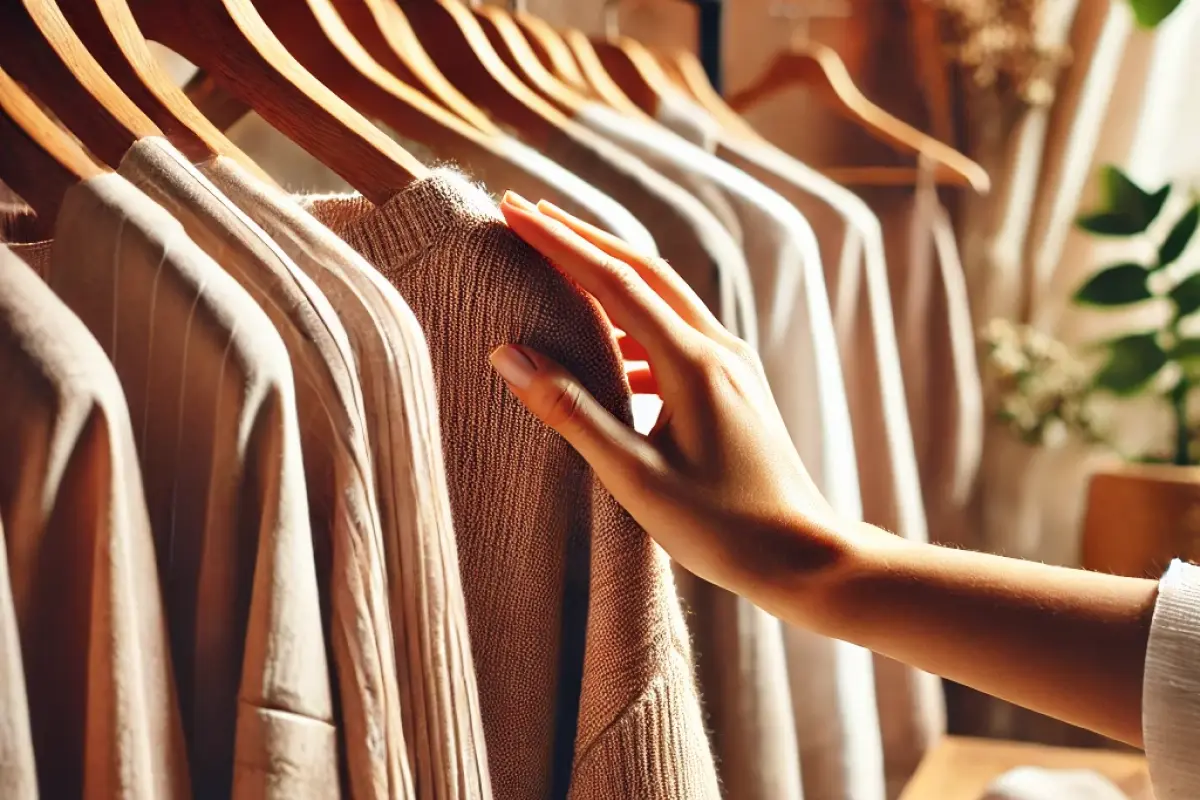
The fast fashion industry has transformed the way people buy and consume clothing. With its low prices and quick production cycles, it caters to consumers who seek trendy styles at affordable rates. However, this business model comes with significant drawbacks, including poor fabric quality, unsustainable production processes, and environmental damage. Unsustainable clothing production methods further contribute to environmental harm and resource depletion, making the need for responsible manufacturing practices more urgent.
As awareness grows, more consumers are prioritizing fashion and quality over cheap, disposable garments. This shift in focus reflects a broader movement toward more responsible and stylish choices that prioritize both aesthetics and durability.
The Pitfalls of Fast Fashion Quality in the Fashion Industry
Fast fashion brands prioritize speed and low costs over quality. Many garments rely on synthetic fabrics, such as polyester, which are cheap but lack durability. These materials often wear out quickly, forcing consumers to replace items more frequently.
The production process for such clothing also involves cutting corners, resulting in inconsistent stitching, uneven seams, and subpar finishes. This race to produce quickly and cheaply creates a cycle of poor craftsmanship and consumer dissatisfaction.
Moreover, the environmental impact of fast fashion cannot be ignored. Synthetic materials take decades to decompose, contributing to growing landfills. The industry also generates high levels of pollution during the manufacturing process, including water contamination and greenhouse gas emissions. The overuse of synthetic dyes further exacerbates these issues, introducing toxic chemicals into ecosystems.
Another significant drawback lies in the exploitation of workers. Fast fashion brands often outsource production to countries with low labor costs, where working conditions are poor, and wages are meager. These unethical practices have sparked global outrage, prompting calls for more ethical and sustainable alternatives.
Why High-Quality Clothing Matters
Investing in high-quality clothing offers numerous benefits for both consumers and the planet. Quality fashion emphasizes durability, ensuring that garments last for years rather than months. Premium fabric choices, such as organic cotton and natural fibers like linen and wool, provide a better feel, breathability, and longevity.
These materials also have a lower environmental footprint compared to synthetic alternatives. Organic cotton, for instance, avoids harmful pesticides and reduces water usage, making it a more sustainable option.
High-quality clothing materials often come from ethical fashion brands that focus on eco-friendly and sustainable practices. These companies use responsible manufacturing processes, reduce waste, and prioritize the welfare of their workers. By choosing quality over quantity, consumers can align their wardrobe choices with their consumer values. Furthermore, these garments often feature better design, offering timeless appeal that transcends fleeting trends.
Innovations in fabric technology are also transforming the industry. Smart textiles are offering new possibilities for sustainable and high-performance clothing.
The Role of Social Media in Shaping Consumer Preferences
Social media platforms play a significant role in influencing consumer behavior. Influencers and fashion experts are promoting quality clothing as a better alternative to fast fashion. Posts highlighting the benefits of higher-quality garments, including long-term savings and superior craftsmanship, are gaining traction. These narratives help consumers see beyond the initial cost and recognize the lasting value of premium clothing. As a result, these efforts drive greater consumer engagement and foster stronger connections between brands and their audiences.
Additionally, social media exposes the negative aspects of the fast fashion industry. Documentaries and viral posts reveal the unethical business processes and environmental harm associated with low-cost clothing.
These revelations encourage consumers to seek fast fashion alternatives and invest in better clothing materials. Platforms like Instagram and TikTok are important for ethical fashion. Users share tips on creating sustainable wardrobes and finding reliable brands.
How Ethical Fashion is Changing the Game
Ethical fashion brands are reshaping consumer habits by offering high-quality, sustainable options. They use high-quality fabrics and eco-friendly methods to make clothes that are stylish and long-lasting. Organic cotton, a popular choice, requires less water and avoids harmful pesticides, reducing its environmental impact. Many brands are also embracing innovative practices, such as upcycling and using recycled materials, to minimize waste.
These brands also emphasize transparency. Supply chain transparency allows consumers to trace raw materials and understand the production process, ensuring that their clothing aligns with ethical standards.
By supporting such companies, consumers contribute to a business model that values quality and sustainability over profit margins. Ethical brands build stronger connections with their customers. They share stories about their workers and how they make products. This creates trust and loyalty.
The Importance of Good Clothing Materials
Good clothing materials are the foundation of quality fashion. Natural fabrics like silk, hemp, and cashmere provide a luxurious feel and superior performance.
Unlike synthetic fabrics, these materials are biodegradable and have a lower environmental impact. Hemp is strong and needs few resources. This makes it a great option for sustainable fashion.
Blending synthetic materials with natural fabrics can enhance durability and reduce costs without compromising quality. For instance, a small percentage of spandex in cotton fabrics can improve stretch and comfort. However, the key lies in maintaining a balance that prioritizes higher quality over cheap manufacturing shortcuts. Innovations in fabric technology also offer new possibilities, such as biodegradable synthetic blends that combine functionality with sustainability.
Fast Fashion Alternatives for Sustainable Fashion
Consumers seeking fast fashion alternatives can explore options like capsule wardrobes and second-hand shopping. The resale market, a rapidly growing and important part of sustainable fashion, offers consumers access to pre-owned clothing through both thrift stores and online resale sites. A capsule wardrobe includes a limited number of versatile, high-quality pieces that you can mix and match.
This approach encourages thoughtful purchasing and reduces waste. A well-curated capsule wardrobe can be the foundation of any outfit. It helps people get the most use from their clothes while still looking stylish.
Second-hand shopping, facilitated by platforms like thrift stores and online resale sites, extends the lifespan of clothing. It allows consumers to acquire quality fashion at reduced costs while minimizing the environmental impact of new production. These platforms often offer unique pieces that add personality to wardrobes while supporting a circular economy.
Another promising alternative is rental fashion services. Companies that allow consumers to rent high-quality garments for special occasions reduce the demand for one-time-use clothing. This model is gaining popularity among eco-conscious shoppers who value variety without contributing to waste.
The Long-Term Benefits of Quality Fashion
Investing in quality clothing offers long-term advantages. Durable garments reduce the need for frequent replacements, leading to significant cost savings over time. Additionally, well-made pieces retain their aesthetic appeal and functionality, making them reliable staples in any wardrobe. These benefits align with a growing preference for slow fashion, which emphasizes mindful consumption and long-lasting designs. Brands that invest in quality fashion gain a competitive advantage in the market by meeting consumer expectations for durability and sustainability.
Quality fashion also promotes reduced waste. By choosing garments that last, consumers contribute to a circular economy where fewer items end up in landfills.
Ethical production processes enhance sustainability by ensuring that clothing creators care for the environment and workers. For example, brands that focus on zero-waste production try to use every piece of fabric. This helps reduce their environmental impact.
Balancing Style and Sustainability
Fashion and quality can coexist without compromising style. Designers and brands are proving that eco-friendly practices and premium fabric choices result in stylish collections. These garments cater to consumers who want to look good while making responsible choices. High-profile collaborations between ethical brands and designers are showcasing that sustainable fashion can lead, not follow, in creativity. These initiatives reflect emerging trends in the fashion industry, where innovation and sustainability are increasingly shaping the direction of new collections.
For example, managed product design focuses on creating timeless pieces that transcend seasonal trends. This approach reduces the pressure for constant new releases, enabling brands to focus on quality and sustainability. By choosing timeless designs, consumers can build a wardrobe that remains relevant for years. Accessories and layering pieces also enhance versatility, allowing individuals to express their unique style within a sustainable framework.
Behind the Seams: Supply Chain and Logistics in Quality Fashion
The fashion industry is experiencing a profound transformation, driven by rapidly evolving consumer behaviors and the relentless pace of technological innovation. As fashion brands design and deliver new collections, they must navigate increasingly complex global supply chains to meet rising consumer expectations for quality, transparency, and sustainability.
Today’s consumers demand greater transparency from fashion brands, wanting to know not just what their clothes are made of, but also how and where they are produced. This shift in consumer behavior has put pressure on the fashion and apparel industry to address issues such as labor practices, environmental impact, and textile waste. Recent supply chain disruptions, like those seen during the COVID-19 pandemic, have further highlighted the need for resilient, agile supply chains that can adapt to unexpected challenges.
To meet these demands, fashion brands are embracing on-demand production and on-demand manufacturing models. By producing clothing only when there is clear customer demand, brands can significantly reduce waste, minimize unsold inventory, and respond more quickly to changing consumer preferences. This approach not only supports sustainable fashion but also enables brands to offer personalized shopping experiences that resonate with today’s shoppers.
Technological advancements are at the heart of this transformation. Artificial intelligence and machine learning are now essential tools for demand forecasting and supply chain optimization. By analyzing consumer behavior and predicting trends, fashion companies can make smarter decisions about production, inventory, and distribution. These digital tools help brands stay ahead in a rapidly evolving fashion landscape, reducing storage costs and improving customer satisfaction.
The digital transformation of the fashion industry extends beyond the supply chain. Digital sampling and nearshore production are helping brands shorten lead times and reduce waste, while digital platforms and social media channels are revolutionizing the way brands connect with consumers. The rise of digital fashion and virtual fashion—such as digital fashion items and virtual clothing—offers new ways for brands to engage customers, using augmented reality and immersive technologies to enhance the shopping process.
Luxury brands, in particular, are leveraging artificial intelligence and machine learning to create highly personalized shopping experiences. In the luxury market, sustainability and transparency are becoming as important as exclusivity and craftsmanship, with brands recognizing that these values are central to modern consumer expectations.
Across the apparel industry, the push for sustainable fashion is leading to the adoption of circular fashion models, the use of recycled materials, and a focus on reducing textile waste. Fashion companies are also prioritizing inclusivity and diversity, ensuring that their marketing campaigns, product offerings, and hiring practices reflect the evolving values of their customers.
As the global fashion industry continues to evolve, industry leaders and emerging designers alike are turning to technology-driven solutions and digital innovation to stay competitive. The future of fashion will be shaped by a blend of agility, resilience, and a commitment to transparency and sustainability. By embracing these changes, fashion brands can not only meet but exceed consumer expectations, paving the way for a more responsible and innovative fashion landscape.
The Future of Quality Fashion
The rising demand for high-quality clothing signals a shift in consumer priorities. People are no longer content with disposable garments that fail to deliver on durability and style. Instead, they seek value in premium materials, ethical production processes, and sustainable business models. As more people become aware of the hidden costs of fast fashion, the appeal of quality alternatives continues to grow. Market demand for quality and sustainability is driving significant change in the industry, pushing brands to adapt to new expectations.
This trend offers opportunities for brands to redefine their strategies. By using better raw materials and improving their production processes, companies can meet the needs of more aware consumers. Shifting consumer behaviors and evolving consumer values are influencing these strategic changes, prompting brands to prioritize sustainability, inclusivity, and innovation. Emphasizing quality and transparency can also build brand loyalty and drive long-term success. Additionally, governments and organizations are beginning to incentivize sustainable practices, further encouraging the shift toward quality fashion. Rapid technological advancements will continue to shape the future of quality fashion, enabling new solutions for sustainability and efficiency.
Conclusion
The fast fashion industry faces mounting challenges as consumers demand better options. Quality fashion, rooted in high-quality clothing materials and ethical practices, is emerging as a viable alternative. By prioritizing durability, style, and sustainability, brands can meet the needs of modern consumers while minimizing their environmental impact.
Choosing quality over quantity benefits everyone. It allows consumers to build a stylish, sustainable wardrobe that stands the test of time. It also encourages brands to adopt eco-friendly practices and invest in premium fabrics.
In a world dominated by fast fashion, the demand for quality clothing is a refreshing step toward a more responsible and stylish future. With informed choices, this movement can pave the way for a brighter, more sustainable fashion landscape.




